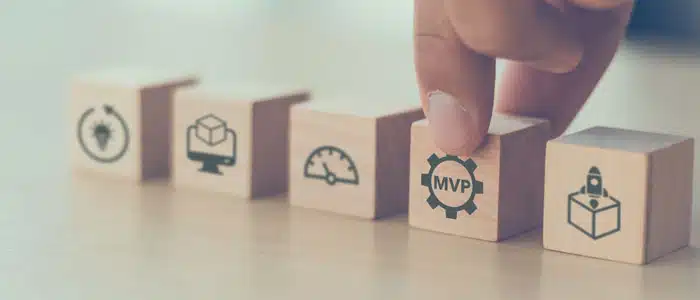
Minimum Viable Product: Guide for Startups
Table of contents
Start-ups face great challenges when developing a product. In addition to the product idea development, they also must think of the production processes, and the material purchasing, all while being under the investors’ pressure. There’s also the difficulty of getting the customers onboard if the product gets onto the market. Exciting challenges call for smart solutions. The good news is, Minimum Viable Product (MVP) is your alternative to conventional production processes.
The Product Idea is Only the Beginning
20% of start-ups fail in their first year, and around 60% will go bankrupt within their first three years. This isn’t always because of a poor business plan or an inferior product idea. Conflicts in the team, inefficient processes or imprecise financial planning can also lead to the early closure of a business. For many reasons, product development is one of the greatest challenges that start-ups face in their formative years.
Product Development Challenges for Start-ups
- High Cost: Whether you manufacture digital software solutions or physical products, you cannot do it without modern technologies, raw materials, and a team. New product development costs money, and founders must carefully plan their finances. Especially as it’s rare for start-ups to have sufficient equity, and so it’s likely you’re highly dependent on investors.
- Time: Manufacturing a product can take months or years. During this time, your start-up must sustain itself. The development of complex products can also cause delays due to new-found errors. When the product’s ready for production, it’s time to initiate sales and marketing activities. At this point, there’s a considerable risk that start-ups will have liquidity issues. Start-ups also often fail because of their attention to details. But then, there’s always something to improve. The problem is that the competition is fast and can bring a comparable product by the time you produce the perfect product.
- Idea Theft: The fear of seeing your idea stolen leads to secrecy. But this gives rises to another concern: you’ll struggle to determine whether your product idea is worth something and end up relying on your intuition, which is not always the best guide.
- Market Analysis: Start-ups should research whether there are any buyers for their product and what their requirements are. Unfortunately, well-considered market analysis is time-consuming and large-scale market research is costly.
- Structures and Processes: Start-ups don’t typically establish structures and processes that provide a stable framework for business and product development early on. It’s also worth noting that hiring the right people is a significant challenge for start-ups in product development.
Developing a product is not an easy task. First you must find investment, then you earn the privilege of hoping that your product will recoup the considerable costs. This is a risk that few start-ups take successfully. However, the Minimum Viable Product might be your solution.
What is a Minimum Viable Product?
A Minimum Viable Product (MVP) is a product that meets the minimum requirements in terms of function and design. Simply put, it’s a very basic version of your product.
The idea behind it comes from Eric Ries, the inventor of the lean start-up method, something you can learn more about in our free whitepaper “Start-Ups: Challenges & Opportunities”.
Characteristics of a Minimum Viable Product
The Minimum Viable Product intends to answer challenges faced in Product development. It becomes clear when we take a closer look at the characteristics and properties of a minimum viable product.
- It is a minimally functional configuration of a product.
- It can be developed quickly and has minimal costs.
- It serves as a test to obtain customer feedback for further development and improvement of your product.
Despite its simplicity, your product must be able to provide your customer with a solution to a core problem. Once achieved, you can launch the product and use customer feedback to think about additional features, different design, or simple enhancements. Your product will become more complex, better, and of course, more valuable over time.
What are the Advantages of a Minimal Viable Product?
The Minimum Viable Product could be the solution to your problem, but in case you’re still not convinced, here are the main advantages:
- Efficient use of resources: The development of a minimal viable product takes little time and money and only ties up a fraction of the staff. Therefore, recently founded start-ups that do not have high equity can develop it.
- Valuable empirical values: If you have not yet developed any other product, the MVP is an excellent opportunity to test production processes, teamwork, and cooperation with external partners. You will benefit from this experience when you later develop more complex versions or different products.
- Authentic customer feedback: Even the best market research cannot replace direct exchange with customers. And that’s exactly what you get by selling your MVP. You will learn, step by step, the real needs of your target groups, who are your actual buyers and how you to satisfy these needs by further developing your product.
The last aspect, in particular, is a decisive advantage of the minimal viable product. It prevents you from making serious wrong decisions during product development.
Example of a Successful Minimum Viable Product
Are you reading this post on an iPhone? Then you’re holding the evolution of a minimal viable product. Even Apple used this concept for the development of its smartphones. The first iPhone was reduced to a few core functions. No additional apps could be downloaded, and it wasn’t even able to copy text. These functions were only gradually integrated and ultimately turned the iPhone into a complex smartphone that is now regarded as a model of technical innovation.
Minimum Viable Product for Services
MVPs don’t necessarily have to be physical products. Services can also be designed according to this model. Airbnb’s portal is a proof. The company founders had this idea of a rental platform, but didn’t have sufficient funding. So, they offered people assisting to an event near them, to stay in their homes for the night and then asked for their honest feedback which laid the foundation for development. The Airbnb platform is today used by millions of people around the world.
Minimum Viable Product for start-ups
Would you like to learn more about the possibilities of a minimal viable product? Do you want to give your start-up a real competitive edge with lean processes, or exchange ideas with our experts about sustainable product development? We’d love to start a dialogue and show you the ideal software solutions and tools for your start-up.
Your FREE whitepaper “Start-ups – Challenges & Opportunities” is here. A guide at hand to help you build a start-up in the field of product development!


